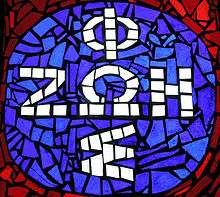Light-Life Movement
The Light-Life Movement (widely known as the Oasis Movement) is one of the movements of renewal in the Catholic Church, according to the teaching of the Second Vatican Council. This movement originated in Poland thanks to the efforts of Servant of God Fr. Franciszek Blachnicki.

The movement brings together people of different age and state: youth, children, adults, as well as priests, monks, nuns, members of secular institutes and families (in the family branch of the Movement called the Domestic Church). The Light-Life Movement is aimed at formation of mature Christians who want to serve the Church and their neighbours.
History
The history of the Movement dates back to the first retreat, which took place in 1954 with the participation of altar boys.[1] Before 1976 movement was known as "the Oasis Movement", "the Movement of the Living Church", "the Movement of the Immaculate." The creator of the oasis, the founder and first national moderator of the movement was Servant of God Fr. Franciszek Blachnicki (buried in Good Shepherd Church in Krościenko), who died in 1987 in Germany where he worked after the beginning of the martial law in Poland. The Light-Life Movement has been founded and developed in Poland but it has already spread to other countries: Slovakia, the Czech Republic, Germany, Belarus, Latvia, Ukraine, Great Britain, Ireland, Canada, USA, Kenya, China and Pakistan. There are also small groups or communities in Norway, Sweden, Greece, France, Belgium, Luxemburg and Bulgaria. There are no exact figures on the number of members of the Movement.[2]
Programme
Spirituality of the Light-Life Movement has been expressed in The Guideposts of the New Man.[3] The formation programme is at the heart of the Movement and is based upon the document Rite of Christian Initiation of Adults.[4] There are three steps to formation. The first is evangelization which leads to the reception of Jesus Christ as one's Lord and Saviour, a conscious decision to follow Him and to live according to His law. The second stage is called deuterocatechumenate and corresponds to the early Christian catechumenate, a period of preparation to baptism. Deuterocatechumenate is a second catechumenate because people who participate in formation have already been baptized. The third stage of formation, described by the Greek word diakonia, is the selection of a specific service and apostolate.
Basic methods of formation of the program are:
- "light-life" method which permeates all elements of the formation, the unity of faith and life;
- retreats called "oases"
- small group formation (meetings in small groups devoted to prayer and talk on different aspects of Christian life).
The structure of the Movement is compatible with the structure of the Church. Small groups of the members of the Movement usually form a community in a parish.
Priests belonging to the Movement serve as its moderators. They are responsible for the spiritual formation of the members of the Movement and for the ecclesial character of the communities. The person responsible for the whole Movement is the General Moderator of the Light-Life Movement. On the level of the state, diocese, and parish the responsible are respectively state, diocesan and parish moderators.
General moderators
- Rev. Franciszek Blachnicki (to 1981)
- Rev. Wojciech Danielski (1981-1985)
- Rev. Henryk Bolczyk (1985-2001)
- Rev. Roman Litwińczuk (2001-2007)
- Rev. Adam Wodarczyk (2007-2015)
- Rev. Marek Sędek (since 2015)
